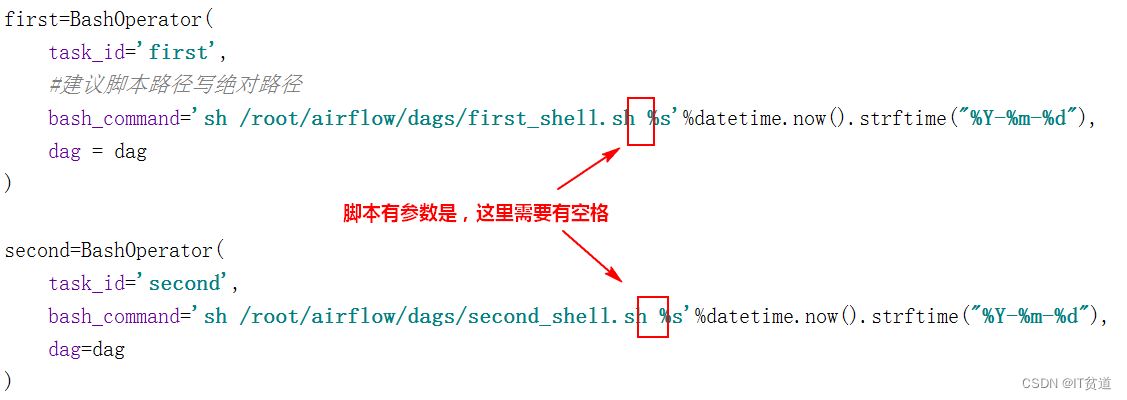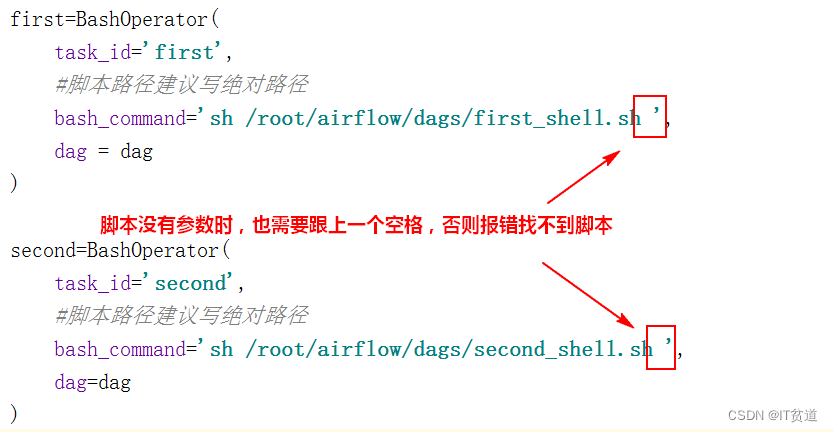Apache Airflow (九) :Airflow Operators及案例之BashOperator及调度Shell命令及脚本

🏡 个人主页:IT贫道_大数据OLAP体系技术栈,Apache Doris,Clickhouse 技术-CSDN博客
🚩 私聊博主:加入大数据技术讨论群聊,获取更多大数据资料。
🔔 博主个人B栈地址:豹哥教你大数据的个人空间-豹哥教你大数据个人主页-哔哩哔哩视频
目录
1. BashOperator 调度Shell命令案例
2. BashOperator 调度Shell脚本案例
Airflow中最重要的还是各种Operator,其允许生成特定类型的任务,这个任务在实例化时称为DAG中的任务节点,所有的Operator均派生自BaseOparator,并且继承了许多属性和方法。关于BaseOperator的参数可以参照:
http://airflow.apache.org/docs/apache-airflow/stable/_api/airflow/models/baseoperator/index.html#module-airflow.models.baseoperator
BaseOperator中常用参数如下:
task_id(str) : 唯一task_id标记
owner(str):任务的所有者,建议使用linux用户名
email(str or list[str]):出问题时,发送报警Email的地址,可以填写多个,用逗号隔开。
email_on_retry(bool):当任务重试时是否发送电子邮件
email_on_failure(bool):当任务执行失败时是否发送电子邮件
retries(int):在任务失败之前应该重试的次数
retry_delay(datetime.timedelta):重试间隔,必须是timedelta对象
start_date(datetime.datetime):DAG开始执行时间,这个参数必须是datetime对象,不可以使用字符串。
end_date(datetime.datetime):DAG运行结束时间,任务启动后一般都会一直执行下去,一般不设置此参数。
depends_on_past(bool,默认False):是否依赖于过去,如果为True,那么必须之前的DAG调度成功了,现在的DAG调度才能执行。
dag(airflow.models.DAG):指定的dag。
execution_timeout(datetime.timedelta):执行此任务实例允许的最长时间,超过最长时间则任务失败。
trigger_rule(str):定义依赖的触发规则,包括选项如下:{ all_success | all_failed | all_done | one_success | one_failed | none_failed | none_failed_or_skipped | none_skipped | dummy(无条件执行)} default is all_success。BashOperator主要执行bash脚本或命令,BashOperator参数如下:
bash_command(str):要执行的命令或脚本(脚本必须是.sh结尾)1. BashOperator 调度Shell命令案例
from datetime import datetime, timedelta
from airflow import DAG
from airflow.operators.bash import BashOperator
default_args = {
'owner':'zhangsan',
'start_date':datetime(2021, 9, 23),
'email':'kettle_test1@163.com', #pwd:kettle123456
'retries': 1, # 失败重试次数
'retry_delay': timedelta(minutes=5) # 失败重试间隔
}
dag = DAG(
dag_id = 'execute_shell_cmd',
default_args=default_args,
schedule_interval=timedelta(minutes=1)
)
t1=BashOperator(
task_id='print_date',
bash_command='date',
dag = dag
)
t2=BashOperator(
task_id='print_helloworld',
bash_command='echo "hello world!"',
dag=dag
)
t3=BashOperator(
task_id='tempplated',
bash_command="""
{% for i in range(5) %}
echo "{{ ds }}"
echo "{{ params.name}}"
echo "{{ params.age}}"
{% endfor %}
""",
params={'name':'wangwu','age':10},
dag=dag
)
t1 >> t2 >> t3注意在t3中使用了Jinja模板,“{% %}”内部是for标签,用于循环操作,但是必须以{% endfor %}结束。“{{}}”内部是变量,其中ds是执行日期,是airflow的宏变量,params.name和params.age是自定义变量。
在default_args中的email是指当DAG执行失败时,发送邮件到指定邮箱,想要使用airflow发送邮件,需要在$AIRFLOW_HOME/airflow.cfg中配置如下内容:
[smtp]
# If you want airflow to send emails on retries, failure, and you want to use
# the airflow.utils.email.send_email_smtp function, you have to configure an
# smtp server here
smtp_host = smtp.163.com
smtp_starttls = True
smtp_ssl = False
# Example: smtp_user = airflow
smtp_user =kettle_test2
# Example: smtp_password = airflow
smtp_password =VIOFSYMFDIKKIUEA
smtp_port = 25
smtp_mail_from =kettle_test2@163.com
smtp_timeout = 30
smtp_retry_limit = 5此外,配置163邮箱时需要开启“POP3/SMTP/IMAP服务”服务,设置如下:
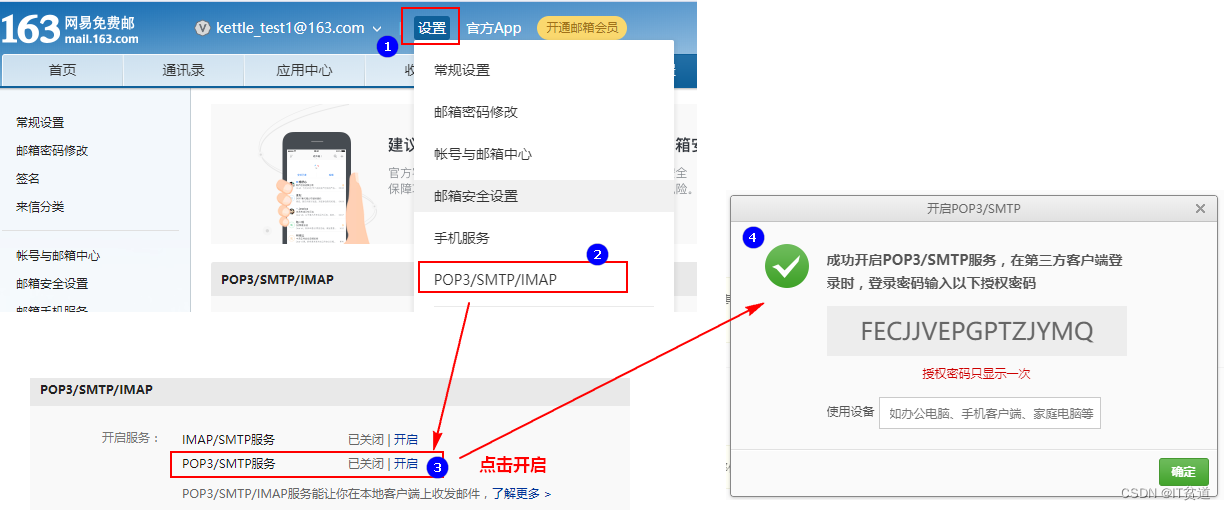
2. BashOperator 调度Shell脚本案例
准备如下两个shell脚本,将以下两个脚本放在$AIRFLOW_HOME/dags目录下,BashOperator默认执行脚本时,默认从/tmp/airflow**临时目录查找对应脚本,由于临时目录名称不定,这里建议执行脚本时,在“bash_command”中写上绝对路径。如果要写相对路径,可以将脚本放在/tmp目录下,在“bash_command”中执行命令写上“sh ../xxx.sh”也可以。
first_shell.sh
#!/bin/bash
dt=$1
echo "==== execute first shell ===="
echo "---- first : time is ${dt}"second_shell.sh
#!/bin/bash
dt=$1
echo "==== execute second shell ===="
echo "---- second : time is ${dt}"编写airflow python 配置:
from datetime import datetime, timedelta
from airflow import DAG
from airflow.operators.bash import BashOperator
default_args = {
'owner':'zhangsan',
'start_date':datetime(2021, 9, 23),
'retries': 1, # 失败重试次数
'retry_delay': timedelta(minutes=5) # 失败重试间隔
}
dag = DAG(
dag_id = 'execute_shell_sh',
default_args=default_args,
schedule_interval=timedelta(minutes=1)
)
first=BashOperator(
task_id='first',
#脚本路径建议写绝对路径
bash_command='sh /root/airflow/dags/first_shell.sh %s'%datetime.now().strftime("%Y-%m-%d"),
dag = dag
)
second=BashOperator(
task_id='second',
#脚本路径建议写绝对路径
bash_command='sh /root/airflow/dags/second_shell.sh %s'%datetime.now().strftime("%Y-%m-%d"),
dag=dag
)
first >> second执行结果:
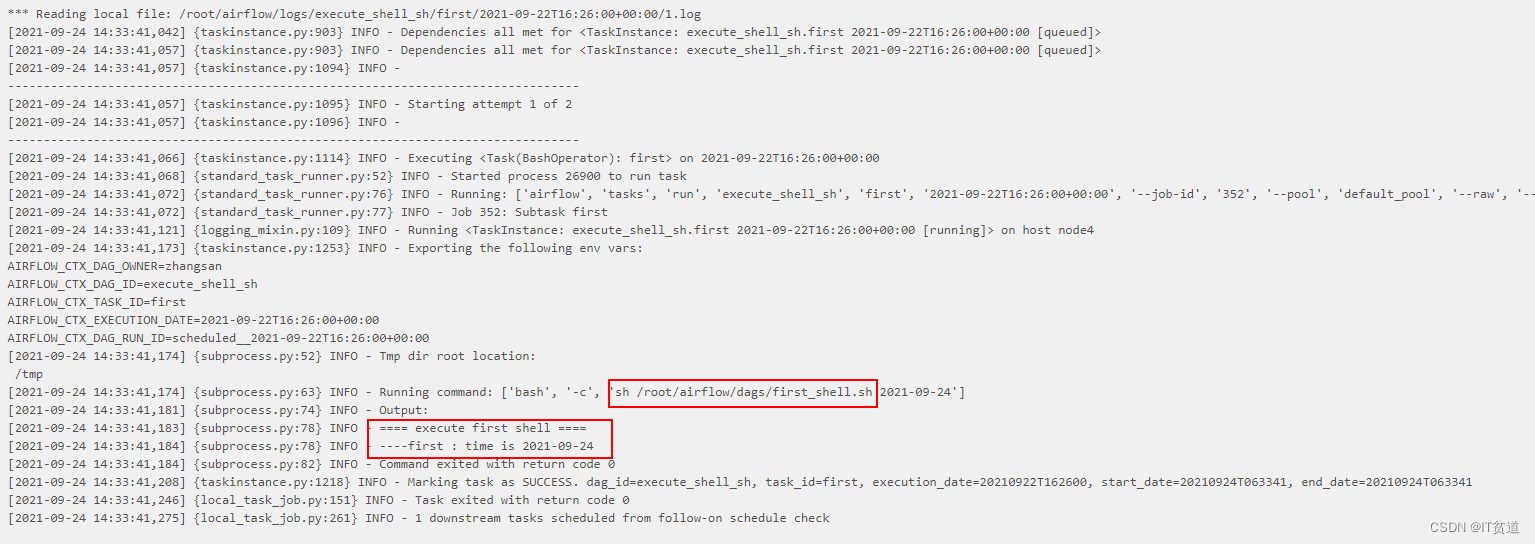
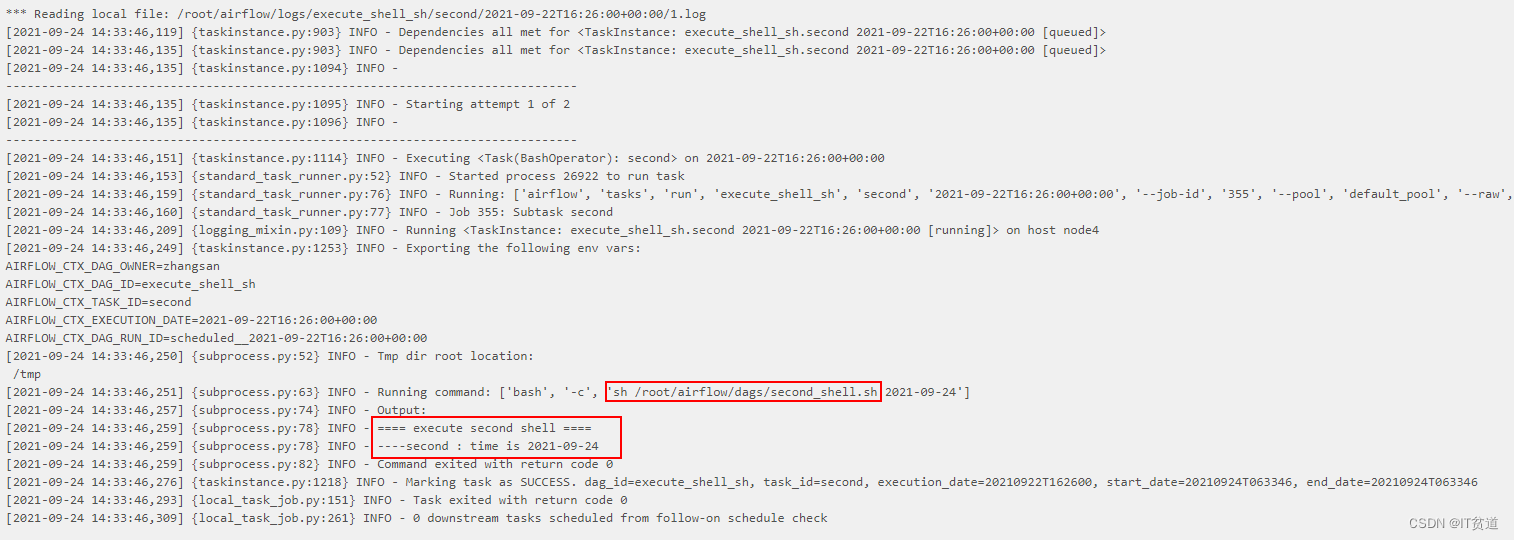
特别注意:在“bash_command”中写执行脚本时,一定要在脚本后跟上空格,有没有参数都要跟上空格,否则会找不到对应的脚本。如下:
